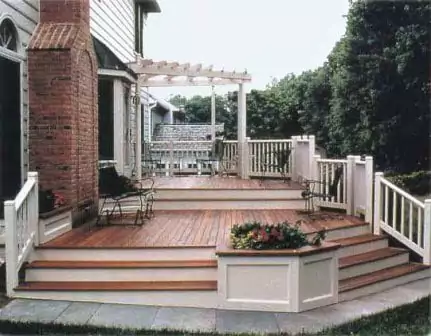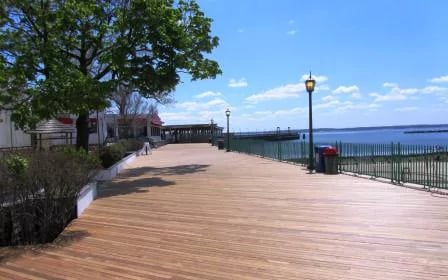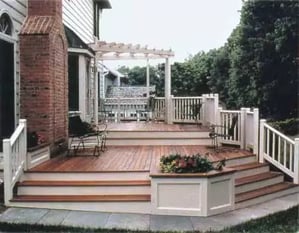
Related Posts



Wood decking and siding are natural products and perform best when allowed to properly acclimate before installation. Proper acclimation to a new environment is important for exterior wood to perform and look its best. When wood decking or siding is first installed, they are most vulnerable to changes in dimensions, especially shrinking, until they adjust to the EMC (Equilibrium Moisture Content) of their new environment. Once exterior wood has adjusted to the local EMC of its new home, changes in dimensions are typically much smaller, occurring seasonally with changes in temperature and humidity.
Synthetic decking and composite decking are  widely known to expand tremendously lengthwise (linear expansion) during periods of high temperature throughout their lifetime usage. During cold weather, plastic and composite decking can show significant shrinkage – mitered joints often open up alarmingly during low temperature periods and can be particularly problematic. On the other hand, natural exterior wood has minimal linear expansion or contraction when used as decking or siding. Wood decking and siding do show some expansion and contraction widthwise (tangential) and sometimes slight expansion or contraction of their thickness (radial) due to changes in humidity levels.
widely known to expand tremendously lengthwise (linear expansion) during periods of high temperature throughout their lifetime usage. During cold weather, plastic and composite decking can show significant shrinkage – mitered joints often open up alarmingly during low temperature periods and can be particularly problematic. On the other hand, natural exterior wood has minimal linear expansion or contraction when used as decking or siding. Wood decking and siding do show some expansion and contraction widthwise (tangential) and sometimes slight expansion or contraction of their thickness (radial) due to changes in humidity levels.
For best results, allow your exterior wood to adjust to the new site where it will be installed. High density hardwoods have proven to be the most durable wood species for outdoor use, but even so, decking and siding species like Ipe, Cumaru, Garapa, Machiche and Santa Maria hardwood, need to properly acclimate for best performance and great looks over time.
Store your exterior wood material off the ground with spacers to minimize moisture from entering the bottom of the stack of wood.
Keep your stack of covered from sunlight on the top, but leave the ends and sides of the wood pile open to let the air circulate (and moisture to escape)
Use ‘stickers’ between each piece of wood decking or siding to allow the air and moisture to move out of each individual piece of lumber, decking or siding.
Put a UV inhibiting coating on the wood initially to help minimize changes and surface checking during acclimation.
Plan and allow for proper ventilation under decks and outdoor structures. Ground side moisture underneath a poorly ventilated deck and hot drier conditions on the decking above will cause the deck boards to want to ‘cup’ upwards, like a flower petal toward the sun.
It is a scientific fact that all exterior wood species expand and contract with seasonal changes in their moisture content. After exterior wood has had a chance to acclimate fully to its new site, changes in dimension are minimal. In general, the more slowly a wood acclimates and adjusts, the better the short term and long term appearance and performance of the wood.  Summertime temperatures can get so hot you can actually fry an egg on a car’s hood. Think about that for a minute – why wood your wood decking and siding behave any differently? Take proper care to allow the wood to adjust to its new environment.
Summertime temperatures can get so hot you can actually fry an egg on a car’s hood. Think about that for a minute – why wood your wood decking and siding behave any differently? Take proper care to allow the wood to adjust to its new environment.
Regardless of which wood species you select for your exterior decking or siding project, take proper care to protect the wood during its acclimation period and your efforts will be rewarded with a longer lasting, better looking exterior structure. Just because high density hardwood decking and wood siding species perform incredibly well in many conditions, doesn’t make them immune to the hostile effects of nature, especially during acclimation. High density hardwood decking and siding will last amazingly well in a wide range of extreme environmental conditions from desert hot to arctic cold and humid as well as arid conditions. Taking proper care to allow your exterior wood to adjust is the best way to ensure that your investment is protected for many, many years to come.
Follow any of the links below to learn more about high density hardwoods and mechanical properties of various wood species:
Mechanical Properties of Many Exterior Wood Species
Care and Maintenance of High Density Exterior Hardwoods
REQUEST A FREE DECKING QUOTE TODAY
For a wealth of information about all the most commonly used decking materials including wood species and synthetic decking materials, download the widely acclaimed white paper, “The Ultimate Guide to Selecting the Right Decking Material”. Download your FREE Decking Guide today by clicking on the button below:


